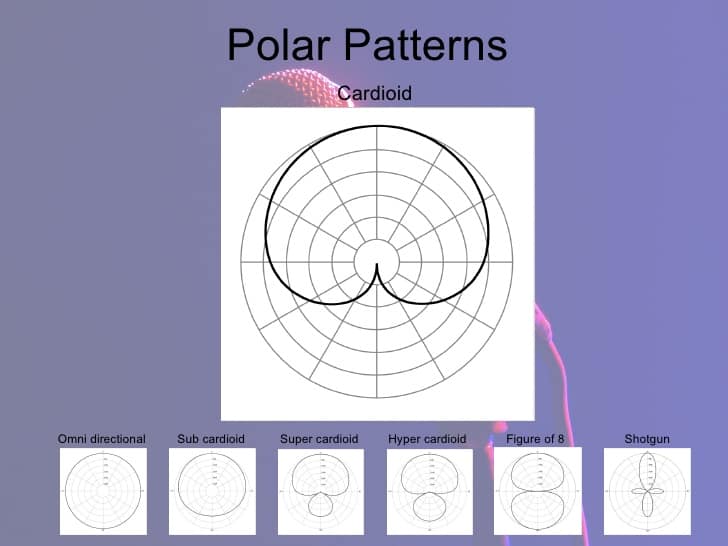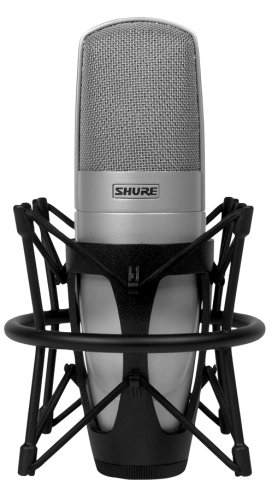Before there was amplification. Places like The Ryman Auditorium and The Grand Ole Opry used acoustics and a player’s projection on stage to control volume, until progressing to a One Mic Technique that is becoming popular once again. What is the One Mic Bluegrass Technique?
The One Mic Bluegrass Technique uses a Large Diaphragm Cardioid Condenser Mic that runs through a high-quality preamp using 2 main Mic Placements. One position is high at the head & mouth level and the other is positioned low at the instrument level.
Since the 1920s and 30’s the Single Mic Technique has made its way through radio broadcast and into the recording studio from the live stage. This old fashioned technique has been making a comeback lately.
Traditional Bluegrass Band
Folk and Bluegrass players typically using a large-diaphragm cardioid condenser. It picks up sound with amazing clarity, especially in a good room. and usually with very good gain before feedback. using one mic can actually solve a few problems before they start.
It’s been my experience that the less live microphones on stage the better. The problems of Feedback and Phase Cancellation are less and the vocals seem to come off clearer, that’s in a perfect world of course. the guy that mixing the sound is a big part of that success. Before Amplification and microphones, stepping up meant projecting your sound to the front closer to the audience.
This way the audience could focus on the lead instrument or vocalist. The technique originated as a way to get a little more volume from essentially acoustic performances.
A band could be heard in a larger hall and that was a good thing. Because audiences were used to the sound of unamplified instruments. These days a lot of engineers and even audiences approach performances with an expectation of much higher volume levels and get frustrated when they can’t achieve them with this technique
The masters of this One Mic Technique are Bluegrass players. I’ve seen the 5 foot tall skinny little girl appear, step up to the front of a group that completely covered her up in the stage and do a Vocal and step back disappearing behind the wall of 6 ft. tall banjo and guitar pickers. Done all in the rhythm of a Boom, chuck 2/4 time. Like a Dance, I thought.
There are some losses to using a One Mic Technique and there is some gain. The band members play and contribute differently in that setting. So they have more work to do. The sound is purer and the quality may be a little more analog that creates authenticity to the performance.
Just like in any acoustics what matters is the room the volume and the placement of the microphone according to where they fit in the group. The Bass player normally in the back while the string instruments are out in front. The louder instruments off to the sides.
Some EQ and fine control are out the window but the space in front of the stage takes on a different dimension. Audiences can hear the musicians from the stage and the PA speakers. It’s up to the musicians that step up the microphone that adds the volume to the mix where the sound man won’t have any control.
This One Mic Technique that can create a ballet of sound that if the Bluegrass or Folk players use the etiquette and balance that they normally grew up using without a microphone. I think its the ultimate in band contribution.
Some performers and engineers prefer to run the mic signal through a high-quality preamp and then feed the preamp’s line-level signal to the front-of-house. The players won’t depend on stage monitors because of the close proximity they have with each other.
It develops a total equalization for the whole sound instead of splitting up for each individual band member. It sounds like what we had to do when we were the “Garageband” when we had no equipment. Herewith the good solid sound man “The Ballet of Sound” on stage, the result could be blended and balanced and beautiful.
Bluegrass Microphone
Several different microphones have been designed throughout the years to accomplish very different tasks. Condenser microphones will pick up a great deal of sound from several directions, while others pick up one focused sound only from one direction. Of this latter group, the cardioid microphone is perhaps the most popular, as it picks up almost exclusively the desired sound while ambient noise is hardly noticeable.
Some typical applications for the KSM32 are listed below. Microphone use, however, is a matter of personal taste. The KSM32 may be used for a variety of applications other than those listed.
- Voice — solo, background, voice-over, broadcasting
- Acoustic instruments — such as piano, guitar, drums, percussion, strings
- Wind instruments — brass and woodwind
- Low-frequency instruments — such as double bass, electric bass, kick drum
- Overhead miking — drums or percussion
- Ensembles — choral or orchestral
- Room ambiance pick-up — guitar amplifier or drums

Cardioid Patterns
It gets its name because of its pattern of sensitivity, which is roughly shaped like a heart when drawn out on an axis. This means that most of the sound it picks up comes from the front of the microphone, while minimal noise is picked up from the rear and only marginal noise is picked up from the sides.
Recording Bluegrass
A condenser microphone is a good choice for recording vocals in a studio environment. It may also be used in a live setting. It is much more sensitive than a dynamic microphone. The Cardioid Pattern has an acceptance level that around 120 degrees.
Don’t confuse Hyper-Cardioid and Cardioids because Hyper Cardiode has a much tighter acceptance level 100 degrees that may block out some side sounds needed in the mix. A Sub-Cardioid will pick up 170 degrees acceptance which is even more spread out. Especially with the One Mic method, you will need a little more hot areas on the mic.
Large Diaphragm microphones don’t work well indoors without a pre-amp.
For musical purposes, the cardioid microphone is particularly useful for live sounds, such as concerts. It can also be used as a vocal mic for presentations, public addresses, and other situations that require a vocal mic. The style is also a good choice for recording concentrated sounds, such as vocals and acoustic instruments that are used in Bluegrass music.
Miking Techniques For Blue Grass.
One Mic Technique incorporates a lot of positions that the musicians have to use. Vocals have to be at a certain distance and if your on a louder instrument than you have to compensate for that.
What if you were a vocalist and an instrumentalist that has dual jobs in the Bluegrass band. You get the idea that the soundman actually has to be part of the band and the musicians have to be part of the overall sound on stage. It’s actually a very hard thing to do. It takes getting used to.
So the first best technique is to really work on being able to pay close to each other and to the mic. Many people place the mic too high, getting it needlessly far from instruments like the guitar and banjo, especially if vocals aren’t a major part of the band’s sound.
Picture lengths of string from each sound source to the mic, and try to balance them all and keep them all as short as possible. One foot makes a big difference.
Microphone Placement for Bluegrass
The best tool for controlling feedback is by using the directionality of the mic’s pickup pattern. In a cardioid pattern, the mic has its full sensitivity in the central 30 degrees in front of the mic; by next 30 degrees, or 60 degrees from directly in front, the level has fallen off 3db; by 90 degrees (at the side of the mic) the level has dropped 6db, or in half, and is dropping very rapidly.
By 30 degrees around to the backside of the mic the sensitivity is much lower and is at its lowest directly backward. To fight feedback you want the greatest contrast between the sensitivity directed towards your instruments and that directed towards anything coming from the PA.
So keep your players to the front of the mic, ideally all within the 60-degree arc. Place your louder instruments to the sides and the quietest in the center. Keep the mic at least some distance behind the main speakers, and keep your monitor, you should only need one a little distance behind the mic from the band’s point of view, don’t put the monitor right at the foot of the mic stand. Use this guy if you can. The KSM32 Microphone
This technique is not for the novice or faint of heart. It requires carefully choreographed movements. For one thing, band members have to gracefully move in and out of the mic pattern without hitting their bandmates in the head with the neck of their instruments.
Del McCoury and his sons have the best technique using one mic or two mics. When all three of them sing vocals, the one with the loudest voice backs away from the mic (usually a KSM32). They mix themselves using few or (more likely) no monitors. Another Mic that’s recommended is Audio Technica AT4033A Condenser Microphone Mic+Case+Bluetooth Headphones through Amazon.
Its all about compensating and thinking ahead about Positioning yourself for the next moment of the song. You have to be aware of tilting and leaning and how that position affects the sound. As a musician, you have to be involved with the whole sound and constant position that you play in the mix. A better way of putting is that each person in the Bluegrass ensemble is part of one conversation. A great video that shows you how is How to Use a Single Microphone
With a One Mic Technique, the band should not underestimate the importance of the role played by the room especially when recording. When using multiple directional mics to record a group it’s usually possible to limit the amount of reflected sound picked up. An omnidirectional mic will pick up a lot of room sound.
I wrote a good article on using less mic to accomplish more worth like in this article called The Best Mic to Use on a Small Choir. Position and Placement is everything andy learning polar patterns can get you a lot of Bang for your Buck with fewer microphones Chech it out!
Acoustically treating a whole room can be a tricky and expensive business. Since we’re talking about the traditional approach with a One Mic Technique, perhaps you’d be best off finding a good-sized room or hall with a naturally pleasing, but not overpoweringly reverberate, sound.
The re-emergence of the single or two mics gather ’round approach is making its way back. It’s been a standard at The Ryman Auditorium for years. The popular microphone position is used by an array of Bluegrass artists. If the microphone position and placement are right and the “One Mic Dance” by the players is done right, the result can be a beautiful acoustic style that can’t be duplicated in any recording studio.
JimGalloway Author/Editor

MikingDesign
Reference:
How to Mic a Bluegrass Band
What are some common ways to mike a live bluegrass band?



